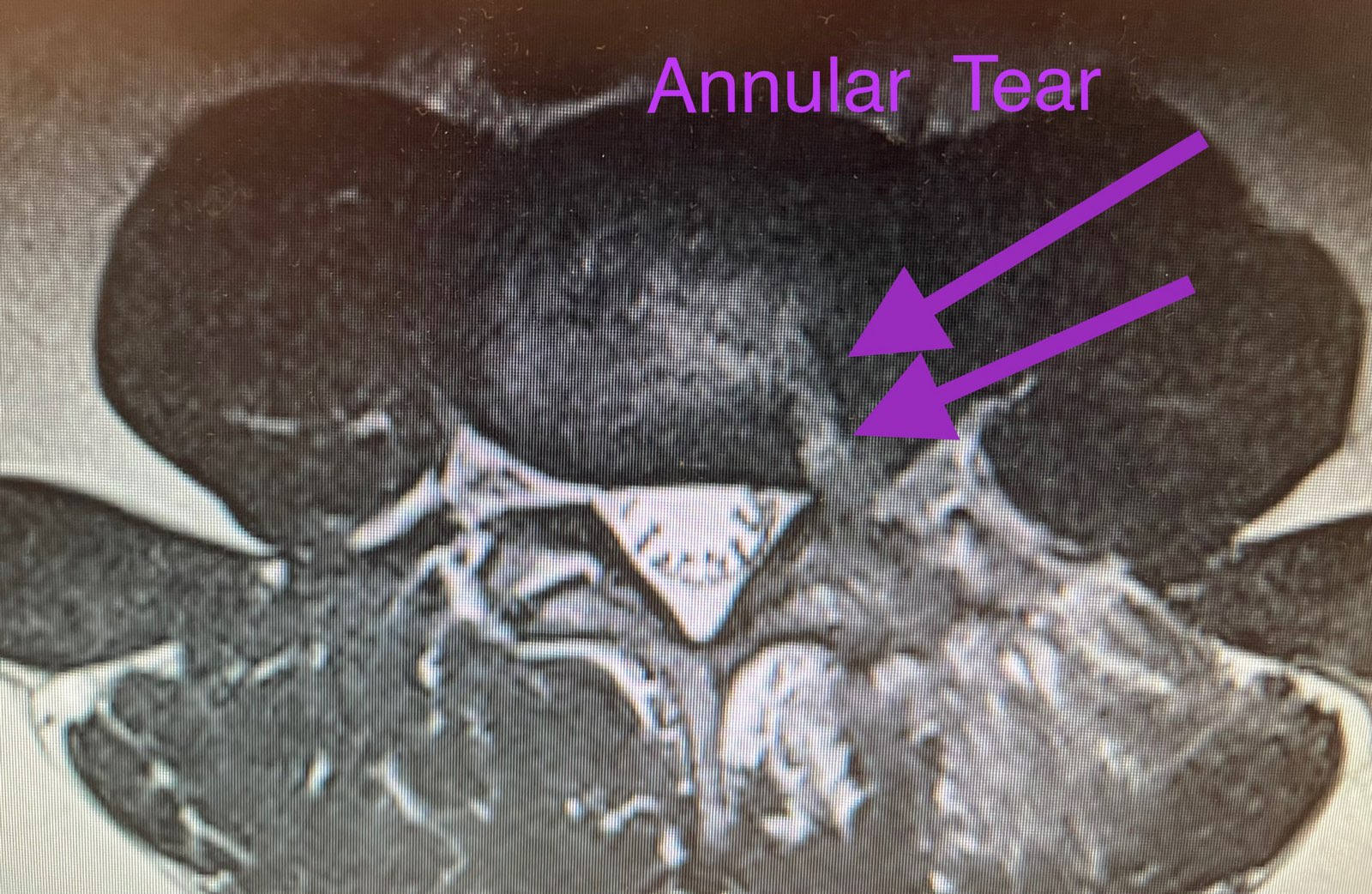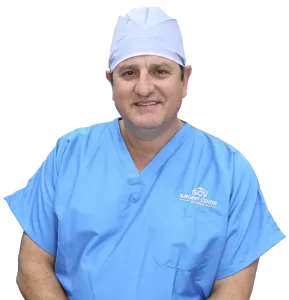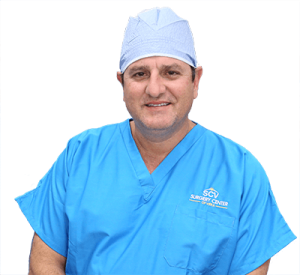If you’re suffering from back and neck pain, one common phenomenon associated with it is Foraminal Stenosis.
Foraminal stenosis is also referred to as foraminal narrowing, foraminal compromise, or foraminal spinal stenosis. It commonly affects people over the age of 50, and it can degenerate into complications like sciatica.
In this article, we’ll cover everything you need to know about Foraminal Stenosis, the causes, symptoms, and treatment options.
The vertebrae are a series of connected bones that make up the spinal column. The flat section of each vertebra is supported by intervertebral discs positioned above and below it. Altogether there are 23 intervertebral discs in the spine distributed across the cervical, thoracic and lumbar spinal segments. The primary function of the spine is to lend flexibility, stability, and support to the upper body.
Nerves within the spinal column transmit signals from the brain to the rest of your body. Such nerves run at each level of the spinal canal and eventually exit the column via small bony openings known as the foramen. These tiny channels are crucial because they aid in the free flow of information between the brain and the rest of the body via the central nervous system. Other spinal cord components are the surrounding tissue and bone, which protect the nerves from shock and impact.
Foraminal stenosis occurs when the openings between the spinal vertebrae begin to compress and narrow. This is often caused by herniated discs and degenerative spine disease and can constrict the spinal nerves. Because one of the nerve roots is irritated, this could impair the nerve’s capacity to function.
Bending forward or sitting may temporarily alleviate foraminal stenosis pain because the space between the vertebrae increases in these positions. Also, people commonly walk in a “hunched over” position because it helps decompress the nerves. However, becoming inactive or walking in a bent/hunched manner can lead to other problems that will worsen symptoms or create new ones altogether. When you walk in a bent position, you risk muscle strain as your body tries to keep your eyes on the horizon instead of the ground.
Foraminal stenosis is very common in the lower lumbar region of the back.
Failure to treat foraminal stenosis or other types of spinal stenosis can result in permanent nerve damage and loss of feeling.
Deuk Spine Institute offers one of the safest and most effective neural foraminal stenosis treatments in the world. With a 95% success rate, fast recovery and it is easy to understand why people come from around the US to have cervical and lumbar foraminal stenosis surgery here. Get a free MRI review.
The spinal column that surrounds and protects the spinal cord is a robustly designed structure but retains flexibility at joints between hard bones called vertebrae. The column comprises 34 bones: 24 articulated vertebrae and ten naturally fused vertebrae of the sacrum and coccyx.
Each vertebra comprises a prominent cylindrical body and a vertebral arch. The spinous process and a facet joint on either side form the arch. Various sections of the vertebra are linked by muscles, ligaments, cartilage, and discs.
The spinal canal is the centrally located space between the arch and the vertebral body. The spinal cord is housed and protected in the spinal canal. The foramina (singular foramen) are additional side apertures on the stacked vertebrae where the nerve roots branch out of the spinal cord and leave the spinal canal to go down arms or legs. A pair of spinal nerves exit the spinal column through the foramina at each disc level of the spine.
A wide range of standard and less-known factors can contribute to the development of foraminal stenosis. In most cases, these conditions develop due to injuries to the joints surrounding the foramen, including the disc and facet joints. When disc or facet joint injuries occur from trauma, inflammation occurs, and scar tissue forms around the joints, causing adhesions between joints and nerves in the foramen. Also, ligaments get thicker and compress nerves. Finally, spinal alignment shifts can cause an even greater degree of narrowing of the spaces between bones, including the foramen.
The standard causes of foraminal stenosis include;
Herniated disc can cause back or neck pain, arm or leg discomfort and even advance into more complicated syndromes such as sciatica, radiculopathy, or myelopathy. We call pain originating in a damaged disc “discogenic” pain.
There are 23 intervertebral discs in the spinal column. These discs are soft tissue joints composed of a hydraulic gelatinous core called the nucleus pulposus encased within a firm outer collagen wall termed the annulus fibrosus. The discs protect the spinal vertebrae and nerves from sudden impact and absorb shock from movements of the spine like bending, twisting and jumping.
Unfortunately, the disc’s outer wall, the annulus fibrosus, can develop traumatic tears (annular tear), allowing the jelly-like nucleus pulposus to push backward out of the tear into the spinal canal or neural foramen.

The part of the jelly nucleus pulposus that pushes out through the tear is called the herniation. In many cases, this hernia can impinge on a nerve, giving rise to inflammation and irritation of the affected nerve.
Untreated disc inflammation can lead to degenerative disc disease. The pain in your back from degenerative disc disease comes from irritated (inflamed) nerve fibers within the nearby annular tear.
Degenerative Disc Disease involves a variety of structural, biochemical, nutritional and molecular changes that occur in the spinal disc over time or following an initial injury to the intervertebral spinal disc in your spine. Degenerative disc disease is a common cause of back pain and neck pain (discogenic pain), sciatica and radiculopathy.
Bone spurs, also known as osteophytes, are calcified, hard lumps of additional bone that develop on the ends of spinal bones or surrounding joints. They frequently occur near joints damaged by osteoarthritis, a disorder that causes painful and stiff joints. Bone spurs can also form when adjacent cartilage or tendons are inflamed or injured. Osteophytes can sprout from any bone, but they’re most common in the neck, shoulders, knees, lower back, fingers, foot, and heels, where cartilage has degraded. Bone spurs are also common around degenerative discs in the spine.
Bone spurs are the body’s natural means of redistributing weight over a greater surface, cushioning the bone. They also decrease the range of motion, inhibiting activities that could create bony stress. The majority of bone spurs do not create any complications. Patients will only develop symptoms like pain and stiffness if the outgrowths rub against other bones or irritate surrounding nerves.
Foraminal stenosis usually develops gradually, with modest or sporadic symptoms at first. Specific actions or positions, such as rotating the head, might aggravate the pain by further compressing and inflaming the nerve in the neck. Symptoms may disappear totally for a short or long time after a flare-up before returning. When symptoms reappear, they might vary in intensity from mild to severe.
Foraminal stenosis does not cause pain independently. Pain, weakness, and numbness due to foraminal stenosis can be attributed to two factors:
Disc herniations, bone spurs (osteophytes), cervical degenerative disc degeneration, and thicker ligaments can directly compress the spinal nerve root. Bone spurs commonly form and impinge on the nerve root at the uncovertebral joint on either side of the vertebrae. Nerve root compression can be caused by decreased disc space due to the intervertebral disc losing moisture and flattening with age.
Biochemical processes also influence nerve root inflammation and injury. Inflammatory substances from a disc herniation can flow onto the spinal nerve root in the foramen, causing it to become inflamed.
When a cervical spinal nerve is irritated, it can cause neurological impairments in the shoulders, arms, and hands, such as numbness or weakness. Permanent numbness and paralysis might result if the nerve compression and related neurological impairments are not treated.
Getting an appropriate diagnosis of foraminal stenosis requires a three-step approach.
Step One:
The first step is a medical review of the patient’s history. The physician in charge must adequately examine the patients medical records, which should have exhaustive information about past illnesses or injuries, medications, chronic health conditions, family history, and past medical procedures.
Step Two:
Once the first step has been completed, the information gathered is reviewed by the physician to eliminate specific scenarios and determine the best route in order to conduct further medical investigation.
The physician conducts a physical examination on the patient, paying particular attention to the affected region for any lesions, instability, and pain. It might also be necessary to incorporate some clinical examination into this stage to assess the affected body parts’ range of motion, reflexes, and perceived sensations.
Step Three:
The physician is sometimes compelled to call for a medical imaging test to determine the location and severity of the condition. The most common test applied in this condition is the MRI scan. The scan is also helpful for picking up on asymptomatic cases.
Want A Free MRI Review? Our world-class surgeons at Deuk Spine Institute are standing by to review your MRI and provide a recommendation on the best way to get you out of pain, permanently. Request a free MRI review.
Several therapies for foraminal stenosis are available, depending on the reason and severity of your symptoms.
In minor cases, complementary therapy techniques might be sufficient to relieve the patient. These include: Stretches, Heat and cold therapy, Strength-building exercises, Hot massages, Acupuncture, Physical Therapy (as seen at the Total Spine and Orthopedics Wellness) and Weight loss which can also ease pressure on the spine and nerve roots.
The physician might also prescribe medication to ease pain associated with foraminal stenosis, such as:
These are examples of anti-inflammatory pain relievers that many doctors would recommend. The patient must always take medication hazards and side effects into account. Warning labels should be read and followed carefully regardless of whether a medication is over-the-counter or prescribed. It’s also critical to inform your doctor or pharmacist about all prescriptions you’re taking, as well as any pharmaceutical allergies.
If non-surgical treatments fail to relieve symptoms, the patient and the doctor may consider surgery. The following surgeries are used in treating foraminal stenosis:
Foraminotomy is a fairly-invasive, open-back surgery that is used to treat the effects of foraminal stenosis in the spine that requires the repositioning of tissues and cutting of bone to alleviate pressure on the nerve. The recovery time for a traditional foraminotomy is slow and steady, with patients driving a car and performing light physical activities after 8 weeks and a full recovery within 18 months.
Deuk Laser Disc Repair is an alternative to dangerous invasive spine surgeries like total disc replacement and spinal fusion. It is the most advanced laser surgery in the world.
This revolutionary procedure was developed by Dr. Ara Deukmedjian MD, a world renowned neuro-spine surgeon and a true pioneer in minimally invasive, laser, and endoscopic back and neck pain treatment.
Deuk Laser Disc Repair is a form of endoscopic spine surgery performed in a state-of-the-art surgery center under sedation while the patient relaxes. This procedure does not compromise or weaken the health and integrity of the spine.
If you have a herniated or bulging disc or chronic back or neck pain, submit your MRI for a free review.
To get started, Deuk Laser Disc Repair requires a very small incision, less than a quarter inch long. A cylindrical rod called a dilator is inserted in the small opening to gently spread the muscle to create a small passage and guide through which the surgery is performed endoscopically. The tip of the dilator is advanced into the symptomatic disc through the tear in the annulus where the herniation originates, and a tube called the retractor slides over the dilator and is carefully positioned into the painful disc. The rest of the entire Deuk laser disc repair surgery will occur inside this narrow tube.
To access the spine, an endoscopic camera is inserted into the tubular retractor to allow the surgeon to guide the laser inside each symptomatic disc. This process ensures that bones and surrounding tissues are not damaged, unlike traditional spinal fusions, microdiscectomy
and artificial discs.
The Holmium YAG laser used in the Deuk laser disc repair is manipulated accurately with millimeter precision under endoscopic visualization to remove only painful inflammatory tissue from the back of the disc. The laser is precisely used to remove damaged disc material that is causing the pain. This process is called debridement of the annular tear and Dr. Ara Deukmedjian MD was the first in the world to use and publish this technique.
Once the laser has removed the inflamed painful part of the annular tear and the herniated nucleus pulposus, the endoscope and tubular retractor are removed, leaving less than one-quarter inch incision in the skin, which can be closed with a single stitch and a band-aid.
The total time for the Deuk laser disc repair surgery is one hour, and the patient is in recovery for about 45 to 60 minutes before being released to go home. Hospitalization is not needed and the risks of hospital-based surgery are avoided.
Also, with the Deuk laser disc repair, there’s no loss of normal movement, and the flexibility of the disc and joint is preserved. With endoscopic Deuk laser disc repair there is no fusion, metal implants or biological material added to the spine. The procedure is all natural allowing your body to heal the herniated or bulging disc itself.
After the surgery, the Deuk laser disc repair patient is back home, enjoying life with a speedy recovery allowing normal activities without pain. Another advantage of Deuk laser disc repair is that no opioids or powerful narcotic painkillers are needed after surgery. Open spine surgeries like microdiscectomy, laminectomy, artificial disc replacement and fusion all cause so much internal trauma that patients are in severe pain after surgery and must take painkillers for weeks after their surgery but not with Deuk laser disc repair.
Foraminal stenosis is a progressive degenerative disorder that affects people as they get older. It is often impossible to prevent it from developing. Likewise, it is irreversible, and all treatment options only serve to alleviate the symptoms and effects of foraminal stenosis.
Fortunately, there are specific steps that can assist patients in minimizing the risk factors of foraminal stenosis and maintain healthy bodies well into old age. Many of these steps are related to lifestyle choices such as;

